INTRODUCTION
The advertising campaign had three separate stages with specific messages and content for each. The first stage called on electors to check and update their enrolment by the close of rolls on 23 February 2018, the second stage encouraged electors to have their say and vote, and the final stage instructed electors on how to fill out their ballot papers.
ECSA worked closely with the government mandated master media agency to ensure the advertising placement strategy targeted audiences that had been underrepresented at past state elections, such as young people and electors from Aboriginal and culturally and linguistically diverse (CALD) backgrounds. The campaign also had a strong focus on engaging South Australians living in rural and regional areas.
This whole-of-state campaign was supported by a successful social media strategy and a range of targeted engagement activities as highlighted throughout this chapter.

COMMUNITY ENGAGEMENT
These efforts commenced with six workshops held in August 2017 with community sector organisations representing the above groups. These helped ECSA identify specific barriers to electoral participation and guide ECSA’s engagement strategies to support electors who need assistance. The partnerships fostered by ECSA through the workshops also enabled ECSA to better target its election messaging by distributing information about the election in community sector publications and digital and social media channels. Sector partners also assisted in the development of accessible electoral services and materials in accordance with ECSA’s Disability Access and Inclusion Plan. This included information videos in Auslan, audio products, administering VoteAssist and distributing material in braille.
ECSA also undertook face-to-face engagement as part of its community outreach in the form of staffed stalls at shopping centres and community events. Members of the public were able to pick up information, ask questions, and even check their enrolment or enrol on the spot.



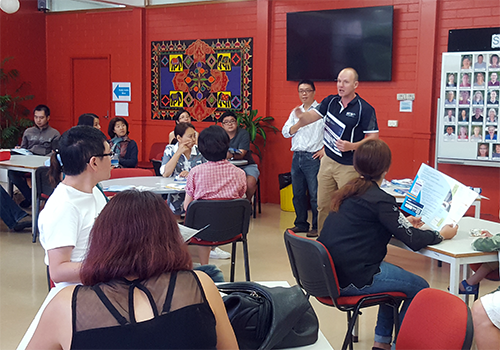
MODERNISING ELECTORAL SERVICES : VOTER EDUCATION
Despite ECSA’s best efforts, the 2018 Electors Surveys revealed that significant proportions of electors were unaware of the voting alternatives available at the State Election. Even among electors who were aware of at least one method of voting other than attending a polling booth on polling day, levels of awareness were poor: 33% were unaware of postal voting, 55% were unaware of absentee voting and 56% were unaware of pre-poll voting.Shortcomings in voter education could be observed in other data. Informality, at 4.1% for both the House of Assembly and Legislative Council elections was at its highest levels since 1982. The Electors Surveys showed that 6% of voters were not confident about completing their ballot papers (up from 2% in 2014), with this figure rising to 14% in young voters aged 18-24.
Clearly, a range of stronger measures are needed to counter the declining levels of participation, formality, youth enrolment, as well as voter awareness and confidence witnessed at the 2018 State Election. Chief among these measures, ECSA identifies a need to devise and deliver a comprehensive voter education program.
The evidence suggests that this program needs to be dual-focused:
- Firstly, an ongoing component specifically targeting new voters (young people and new citizens) to inform them of their rights and responsibilities as electors and how elections work. Studies have shown that education sessions in schools for 17 and 18-year-olds not only increase their knowledge of voting but boost enrolment and turnout by almost 10%. It is particularly important to target school students then because evidence shows that citizens who vote at their first opportunity become life-time voters, while those who do not are likely to become non-voters. Acting on these findings, ECSA will investigate the possibility of launching an ongoing statewide initiative to reach as many Year 11 and 12 students as possible.
- Secondly, a pre-election component raising knowledge and awareness among all voters, firstly about any changes or innovations to voting but more generally about the more complex aspects of the electoral process, such as how to vote formally and how votes translate into seats.
ENGAGING WITH CALD ELECTORS
It is well known that people from CALD backgrounds experience barriers to participation in Australian democracy, with lower rates of enrolment and turnout at elections, and significantly higher rates of informal votes due to poor understanding of the voting process. The two chief barriers to CALD citizens’ enfranchisement as voters are language and voter education issues. The 2016 Census showed around 20,000 South Australians aged 18 or over who are Australian citizens and unable to speak English well or at all. This represents in electoral terms almost as many electors as an entire state electoral district. As part of its efforts to engage and educate CALD electors, ECSA:- published a brochure, ‘Enrolling and Voting at the 2018 State Election’ (pictured below), which was translated into 21 languages and accessed more than 20,000 times via ECSA’s website.
- provided multilingual radio advertising in several languages on 5EBI FM and SBS, as well as in-language print advertisements in a range of multicultural newspapers.
- provided a multilingual guide containing information about how to vote formally in 21 languages at every polling place.
- held stalls at a variety of multicultural events and celebrations.
- employed 99 bilingual polling staff at a selection of polling booths in areas with high densities of CALD community members.
- trialled a Community Ambassador program, as discussed across the page.

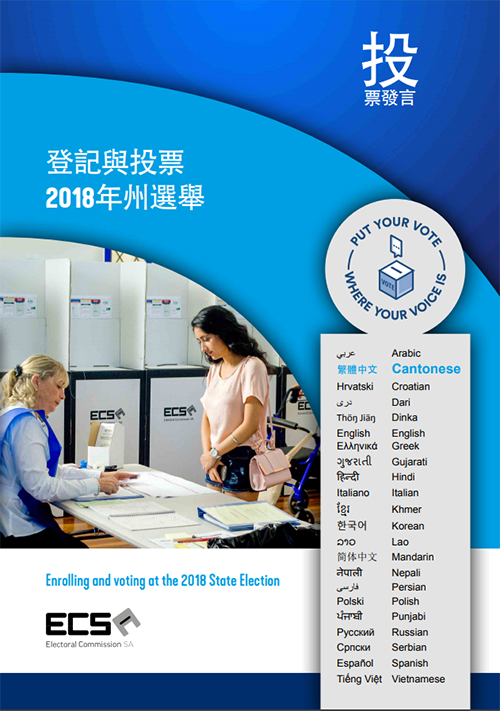
SPOTLIGHT : COMMUNITY AMBASSADORS AT WORK

As part of its expanded community engagement initiative, ECSA introduced a trial of a Community Ambassador program in the lead-up to the election. Multicultural community representatives were identified and trained to assist people from South Australia’s CALD communities to understand their democratic rights and responsibilities and to participate in the electoral process.
Research into South Australia’s demographic and migration trends in consultation with government and multicultural sector peak bodies resulted in four communities being chosen to have Community Ambassadors.
Community Ambassadors spread key messages about the importance of enrolling and voting
Two representatives each from the Afghani, Bhutanese/Nepalese, Chinese and Vietnamese communities were trained as Community Ambassadors. After providing them with training, educational materials and translated information booklets, Ambassadors went out into their communities to educate people in their own language about the election. The Ambassadors spread key messages about the importance of enrolling and voting at the election and how to vote correctly at sessions they organised, as well as cultural events to which they were invited. In total, the Ambassadors held 65 engagement sessions across 22 suburbs, reaching a total of 787 people.
On polling day, Community Ambassadors like Uzair Safi (pictured above), who represented the Afghani community, worked assisting with voting information at polling booths with high numbers of electors from their respective communities. The locations where the Ambassadors and 99 bilingual staff could be found were advertised in multicultural media as well as through our stakeholder partners, our website and social media. Advertising, plus word-of-mouth led to crowds of voters at the indicated polling booths and an extremely busy polling day for our Ambassadors.
In feedback sessions with Community Ambassadors, ECSA learned that some communities’ knowledge of Australian electoral and political systems is very low. To help remedy this, ECSA is evaluating the Community Ambassador program with a view to expanding it at the 2022 State Election.
SPOTLIGHT : ECSA ABORIGINAL ELECTOR SERVICES IN THE APY LANDS – A SUCCESS STORY
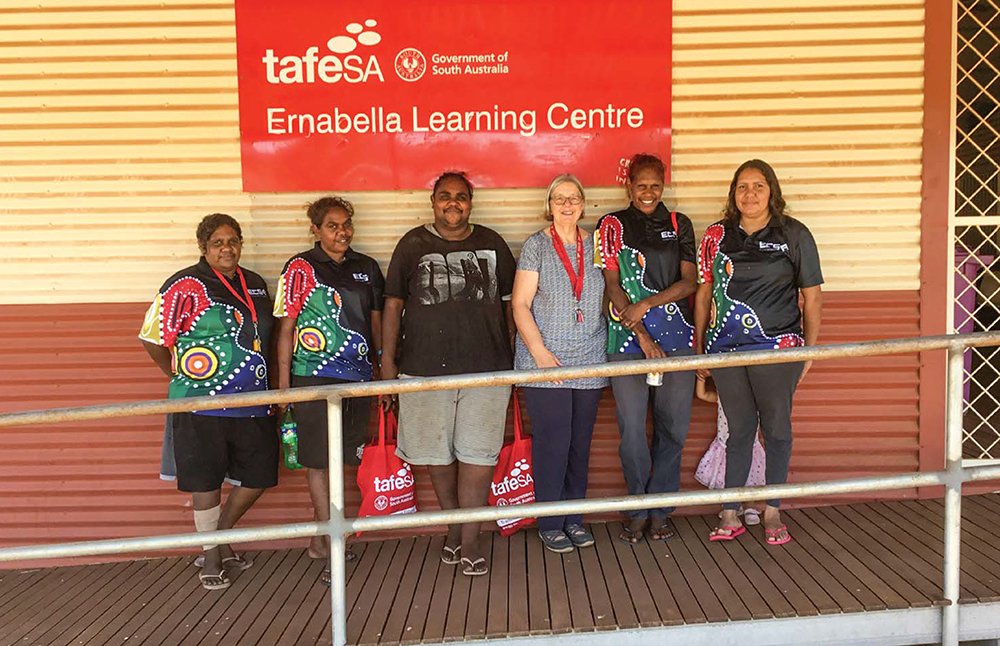
In the second half of 2017, ECSA embarked on its largest and most ambitious program ever to increase voter engagement in Aboriginal communities in South Australia including the Anangu Pitjantjatjara Yankunytjatjara (APY) Lands.
While voting is compulsory for all people enrolled in SA, it is recognised that additional support is needed to ensure that people in Aboriginal communities engage fully at state elections. An ECSA team partnered with the Australian Electoral Commission (AEC) and TAFE SA to develop the enrolment and education strategy for Aboriginal electors in 18 communities across SA.
Two ‘listening tours’ in September and October 2017 allowed the ECSA team to engage with the communities and key stakeholders to develop a culturally appropriate approach towards increasing knowledge and participation in the electoral process.
Regular engagement, face-to-face conversations and feedback loops with local people helped the ECSA team to refine its approach.
Community members assisted the ECSA team in deciding locations for mobile polling, polling times and duration of polling which would best suit the community and increase the chances of a greater turnout.
As a result of the listening tours, ECSA employed 30 Aboriginal Information Officers whose role was to promote the election and manage enrolment in their communities. To assist with voting, the program trained local people in enrolment and how to vote at six TAFE SA locations across the APY Lands in partnership with TAFE SA.
ECSA also engaged two retired AFL Aboriginal champions, Michael O’Loughlin and Gavin Wanganeen, to appear on the opening day of mobile polling to encourage people to vote. Read more.
The program ultimately delivered a demonstrable improvement to the services provided to Aboriginal electors for the 2018 State Election including improvements to the accuracy of the electoral roll and new enrolments leading to a 17% increase in the enrolled population on the APY Lands.
The program was a resounding success when compared with the level of electoral engagement in the APY Lands at the 2014 election. At the 2018 Election there was a 57% increase in polling hours which contributed to an 18% increase in total votes cast at polling locations on the Lands.
Dealing with remote communities can present a unique set of challenges, both logistically and culturally. Face-to-face conversations and the establishment of regular feedback with local people ultimately helped the ECSA team to refine its approach in the lead-up to polling day.
The consultative approach resulting from the listening tours also assisted in the creation of appropriate advertising and voter information material in Pitjantjatjara which included talking posters and a how-to-vote video.
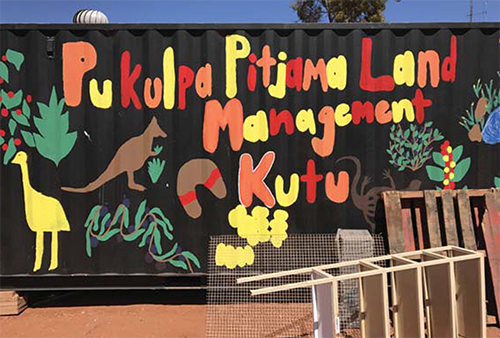
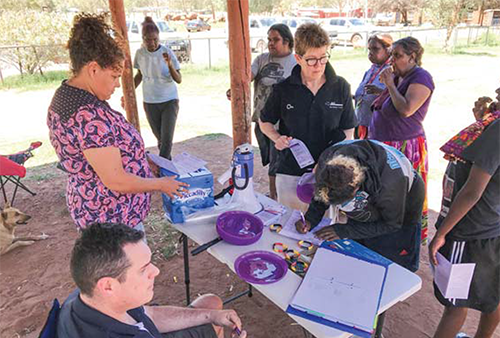
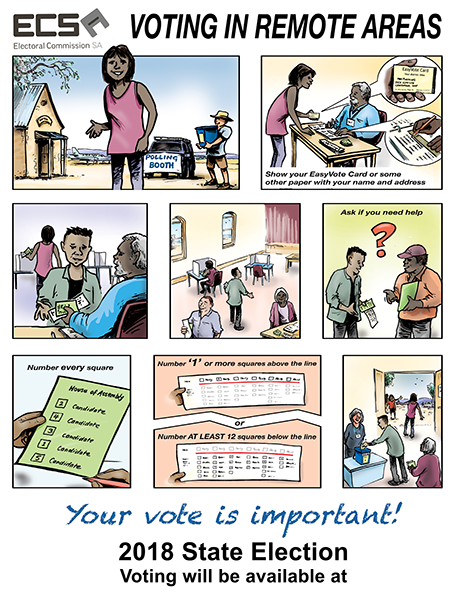
SOCIAL MEDIA
The social media campaign dramatically increased public engagement, particularly among young people, with previously dormant ECSA social media channels taking engagement and activity to new levels.
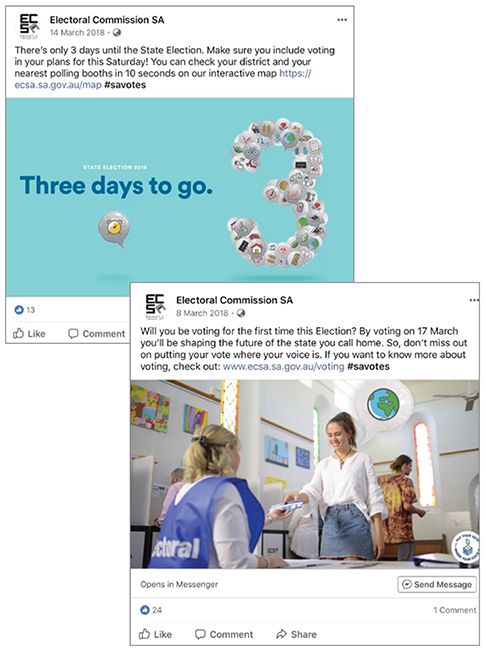
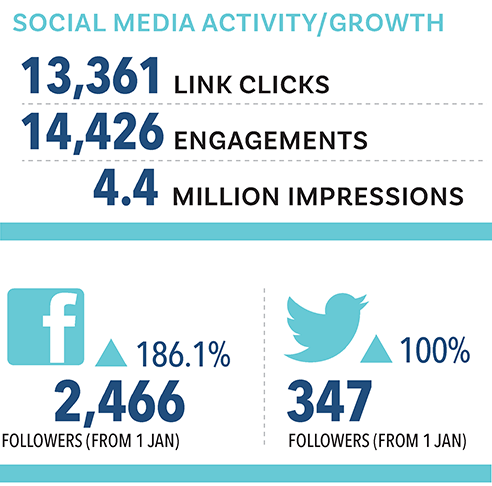
WEBSITE
The ECSA website underwent a major redesign to improve its accessibility functionality for mobile and tablet devices.The desktop version of the website also had greatly improved functionality for users. It provided a simple and clear pathway via a minimum of clicks enabling users to find their electoral district, check their enrolment and locate their nearest polling places.
There were also important accessibility modifications to the website such as ReadSpeaker, text-to-speech software which allowed easy access for hearing impaired users, and a dyslexia button on the home page which altered the website font to make it easier for users with dyslexia to read.
Tracking daily unique user website visits prior to 17 February showed website activity was business as usual with 2,000 to 3,000 visits daily with a spike to 22,000 visits the day before the writs were issued. Once the writs had been issued and the official election campaign had begun, daily visits to the website increased to up to 10,000 per day. Visits spiked again to 22,000 on 5 March, steadily climbing in the lead-up to polling day, 17 March. On polling day unique website visitor numbers peaked at 110,000 with a total number of visits to the website between 1 January to 18 March 2018 of 475,874 and an average stay of two minutes.
Post-election research found that 83% of website users were able to find the information they were looking for easily and the same percentage of users was very satisfied or satisfied with the information provided by the website, with these figures up more than 20% compared to 2014.
ELECTION NOTICES
The Act requires several electoral notices to be published and sets out the publications and timeframes by which these statutory notices must appear. Statutory notices were published in print media and the Government Gazette as required by legislation.
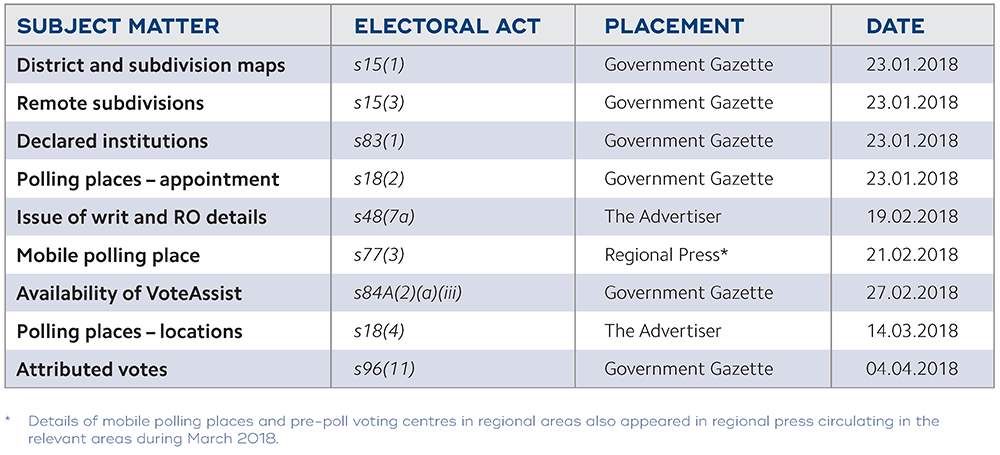
A CALL FOR LEGISLATIVE CHANGE: PUBLIC NOTICES
The Electoral Commissioner is bound by legislation to publish certain statutory notices in newspapers, often at considerable expense. As one example, section 18 of the Act states that, “… the Electoral Commissioner must, between the date of the issue of the writ and polling day, give public notice by advertisement in a newspaper circulating generally throughout the State of the position of all polling places for the district.” To meet this requirement and publish the details of all 693 polling booths used at the State Election, ECSA was required to book four consecutive pages in The Advertiser at a cost of approximately $42,000.Given the high costs involved in publishing notices in newspapers and the prevalence of online and digital media nowadays, ECSA recommends that the Act be amended to allow the Commissioner the flexibility to publish notices on ECSA’s website and by any other means deemed appropriate, instead of in newspapers circulating throughout the state. ECSA notes that this amendment would align with other jurisdictions such as Victoria, where legislation defines publish as “by any means including by publication on the Internet”.
That the Act be amended to remove the obligation for the Electoral Commissioner to publish public notices by advertisement in a newspaper circulating generally throughout the state, so that the notices can instead be published on ECSA’s website or by any other means the Electoral Commissioner deems appropriate.
CALL CENTRE
Call centre responsibilities included answering telephone enquiries from the public, responding to emails through ECSA’s general inbox and mailing out enrolment forms and postal vote applications as requested.
Throughout the eight weeks of its operation, 22 staff were employed, comprising 18 customer service operators, three call centre supervisors and one call centre manager. The call centre also had the assistance of two secondees from interstate electoral commissions for four weeks who provided electoral expertise.
The call centre fulfilled its obligations with telephone calls answered within acceptable timeframes, exceptionally low abandon rates given the volume of calls, and all emails answered within 24 hours.
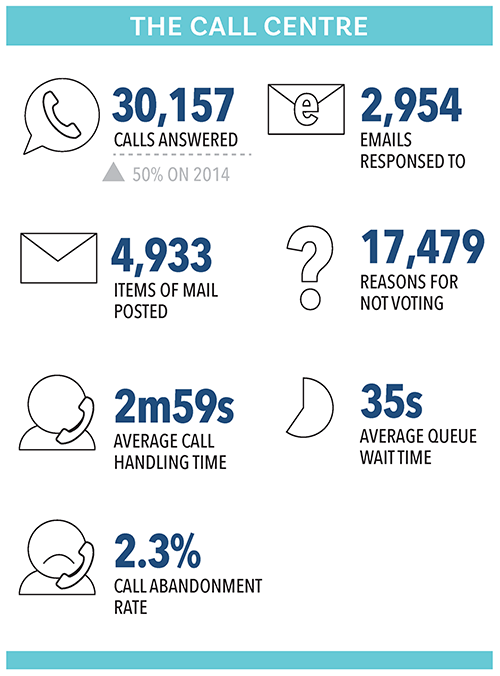
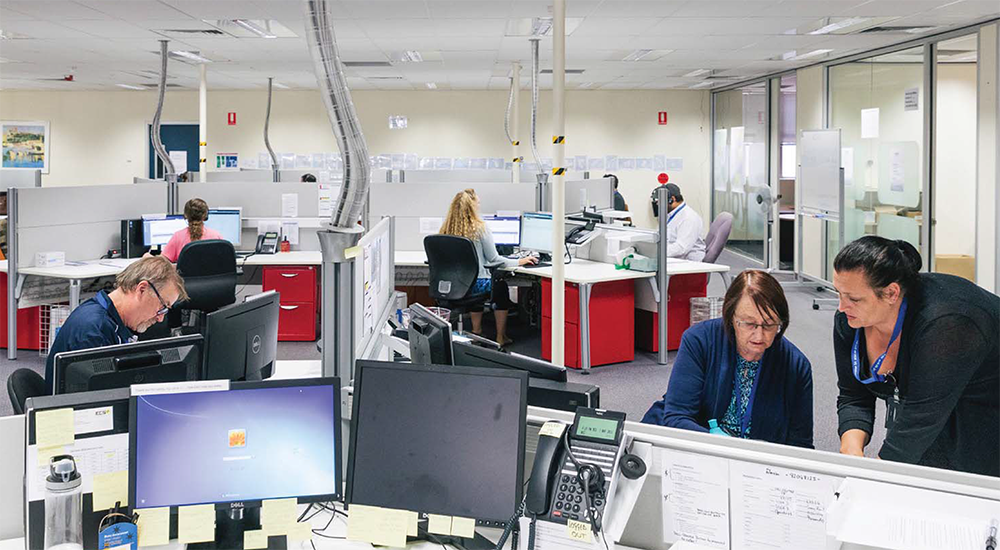
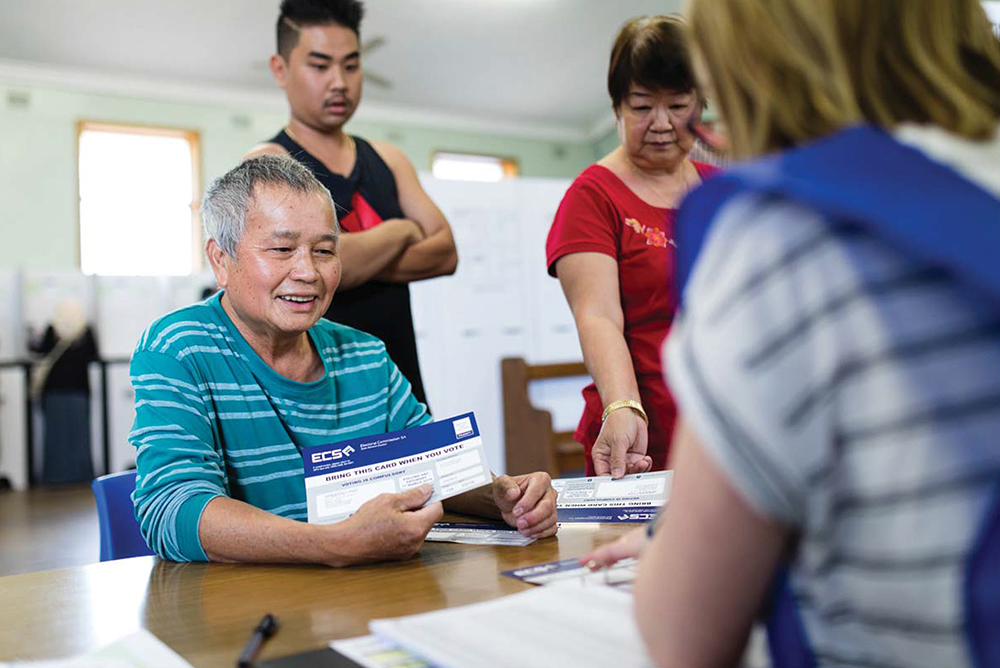
EASYVOTE CARD AND APP
In the lead-up to past state elections ECSA has
mailed personally-addressed information to every
eligible elector across South Australia. For the 2014
State Election this took the form of an election guide
with an EasyVote Card printed on the front page,
which the elector was instructed to detach and bring
with them to the polling booth.
After reviewing the relatively low rate of EasyVote
Card use at that election (less than 50%) and the
approaches taken by other electoral commissions
in recent years, ECSA decided to send out the nearly
1.2 million EasyVote Cards as a stand-alone postcard.
The Cards featured the elector’s enrolment details
on the front, allowing a polling official to quickly
identify and mark the elector off the electoral roll,
as well as a list of the polling booths in the elector’s
district on the back.
While it was not compulsory, an average of 78%
of all electors brought their Card along with them
to vote, significantly speeding up their voting
experience. The Card was particularly valuable
given the significant changes to electoral district
boundaries and the benefit in informing every elector
of their enrolled district and local polling booths.
Feedback from electors and staff about the
convenience and effectiveness of the EasyVote
Card in reducing waiting times to vote was
overwhelmingly positive. The ECSA Surveys of
Electors found that 34% of in-person voters
indicated they had used the Card as their key source
of information about where to vote. 76% of electors
said the Card made it quicker to have their name and
address marked off the electoral roll.
Once a user downloaded the App and entered their personal information the App matched it against the electoral roll and populated their electoral district and enrolment details. Similar to the EasyVote Card, the elector could then go to a polling booth and present the App to a polling official who could quickly find the user on the electoral roll and mark off their name.
In addition to including the same personal enrolment details as the Card, the EasyVote App contained useful information about voting and candidates and a map of polling locations. It also provided updated waiting times for each polling booth, allowing electors to choose a less busy time to vote or to find a booth with shorter queues.
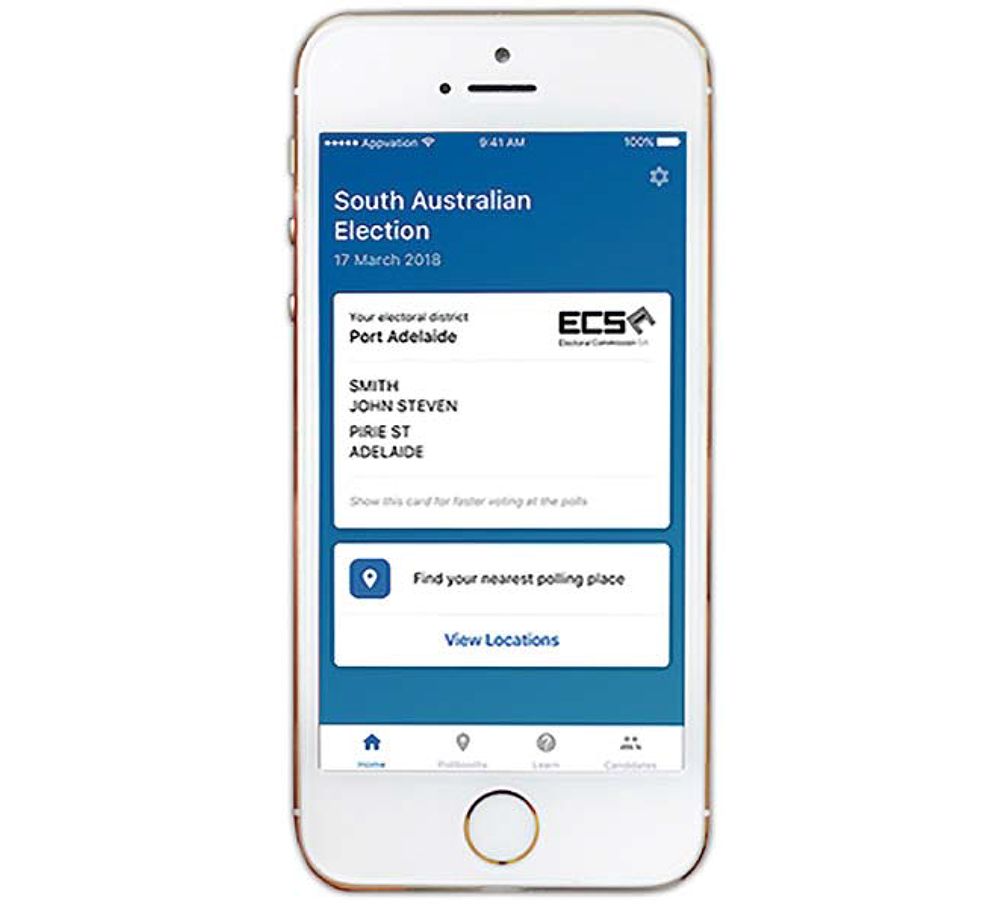
than 34,000 South Australians had downloaded the App. While these figures are respectable in comparison to download statistics for other state government apps, they represent only a fraction of all electors.
Feedback from the Electors Surveys showed that 55% of electors would have been unlikely to use the App even if they had been aware of it. However, given the considerable cost savings that can be generated through use of technologies, ECSA will further explore how the App and other like solutions can be rolled out to electors at the 2022 State Election.
MODERNISING ELECTORAL SERVICES : THE POTENTIAL OF THE EASYVOTE APP
Although engagement with the App was lower than ECSA had hoped for, with sufficient promotion prior to future elections the App has the potential to enhance ECSA’s provision of information and services to voters and generate cost savings.Savings could be generated through higher use of the App, given that each elector who obtains their EasyVote details via the App does not require an EasyVote Card to be printed and posted.
The EasyVote App offers a range of exciting possibilities for future elections, including:
- serving as one of the means by which electors could apply electronically for a postal vote, as per Recommendation 6 of this Report.
- supporting electors to conveniently manage their enrolment information.
- integrating Radio-Frequency Identification (RFID) technology to assist in roll mark-off and prevention of multiple voting.